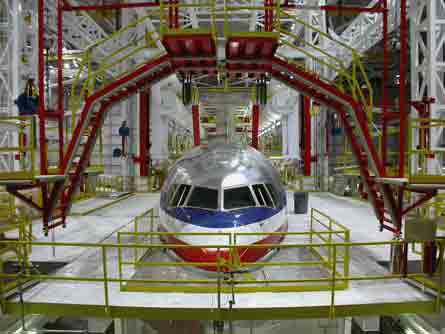The US National Transportation Safety Board has revealed that a mechanical problem and complicated weather could have combined to cause the runway excursion of a Continental Airlines Boeing 737-500 at Denver International Airport on 20 December last year.
Continental Flight 1404 was taking off from Denver at 18:18 when pilots lost directional control as the aircraft reached approximately 100kt (185km/h). The aircraft departed the left side of Runway 34R, coming to rest in a drainage basin and catching fire. Forty-one of the 115 passengers and crew on board were injured.
 |
|---|
© Continental |
In a systems group reports released this month - one of dozens of factual reports that include crew statements, flight data and cockpit voice recorders and meteorology - the NTSB reveals that a cable used to operate the aircraft's nose wheel steering (NWS) system had been found broken in the wreckage.
Pilots steer an aircraft on the ground using the rudder pedals, which directly control the nose gear through control actuators, or at lower speeds using the cable-controlled NWS, which connects to the "tiller" wheel on the left side of the cockpit.
A materials analysis of the removed broken NWS cable by the NTSB found issues "typical of internal wear at a pulley location" in the cable in the vicinity of the pulley where the break occurred. A portion of the recovered cable was also "kinked" at several locations, with a single wire strand fractured at the worst kink locations. An analysis of a NWS cable earlier removed from another Continental 737 due to "visible wear" showed certain external wear features also noted on the accident aircraft's cable.
According to Boeing, the broken cable in that location could have caused the nose gear to rotate 7 degrees to the left. This also represents the maximum amount of nose wheel steering provided by full deflection of the aircraft's rudder pedals, according to the NTSB.
Magnifying the NWS problem that night would have been the strong left crosswind conditions during the take-off roll, winds that would have pushed the aircraft's tail to the right and nose to the left due to the "weathervane" effect.
An analysis of the airport's low-level windshear alerting system, compiled by the National Centre for Atmospheric Research and provided in the NTSB reports, shows that crosswind velocities during the take-off run varied between 25kt and 30kt, just slightly below the winglet-equipped Boeing 737's maximum demonstrated crosswind component of 33kt.
Statements from the pilots would tend to lend credence to a "perfect storm" scenario where a broken steering cable and strong crosswind might have combined to overwhelm the directional controllability of the aircraft.
"Initially, the take-off roll was relatively smooth, with no shimmying or shaking of the aircraft," stated the aircraft's captain, who was performing the take-off.
"However at about 90kt (prior to the monitoring pilot's 100kt call out), I felt the rear end of the aircraft slip out hard to the right and the wheels lose traction. It had felt like a slick patch of runway, or a strong gust of wind, or a combination of both, had pushed the tail hard to the right. The aircraft tracked left and I countered with right rudder to full right. This was ineffectual."
Source: Flight International























